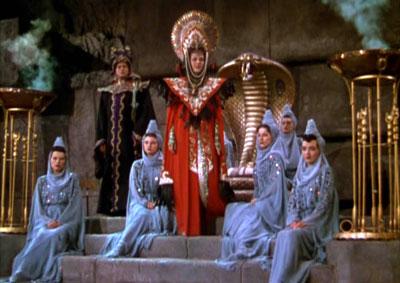Directed by Robert Siodmak
The fourth of Universal’s costume adventures pairing Jon Hall and Maria Montez, Cobra Woman provided a welcome bit of tropical escapism to war-weary audiences. Filmed in lush Technicolor with ornate sets and lavish, bejeweled costumes, this fanciful romp is truly a feast for the eyes, if not for more rational faculties.
In a definitive performance, Montez, her cult status as the “Queen of Technicolor” already taking shape, plays dual roles as virtuous princess Tollea and her evil twin Naja, the iron-fisted, fabulously attired ruler of Cobra Island. As its name suggests, Cobra Island is a cheery place where strangers are instantly put to death, and inhabitants are periodically thrown into the local volcano at Naja’s whim. Such a state of affairs is bad for community morale so Tollea is compelled by her inexplicably British-accented grandmother to put an end to Naja’s wicked ways.
Wickedness aside, Naja’s ways are a spectacle not to be missed. Her cobra dance, the elaborate ritual by which she chooses her victims, is a visual marvel, as she writhes and contorts—in a sparkling silver evening dress—around a giant cobra. The kitschy splendor of this scene would later prove highly influential to underground filmmaking, particularly on the emergence of a camp aesthetic as articulated by Jack Smith in his famous essay, “The Perfect Filmic Appositeness of Maria Montez,” and his more infamous film, Flaming Creatures (1963). Divine’s over-the-top performance in John Waters’ Female Trouble (1974) also bears the unmistakable influence of the cobra dance.
Cobra Woman featured a lively mix of talent all around, including Lon Chaney Jr., here downgraded from terrifying monster to mute henchman; director Robert Siodmak, who would take a very different approach to good and evil twins two years later in The Dark Mirror; and then screenwriter Richard Brooks, who had penned the previous Hall-Montez escapade White Savage (1943), and would go on to write and direct such landmark films as Cat on a Hot Tin Roof (1958) and In Cold Blood (1967). One wonders at, but is grateful for, such a fortuitous combination.
—Nina Rao
Universal Pictures. Producer: George Waggner. Screenwriter: Gene Lewis, Richard Brooks. Cinematographer: George Robinson, W. Howard Greene. Editor: Charles Maynard. Cast: Maria Montez, Jon Hall, Sabu, Mary Nash, Lon Chaney.
35mm, color, 70 min.






 Mobile Navigation
Mobile Navigation

